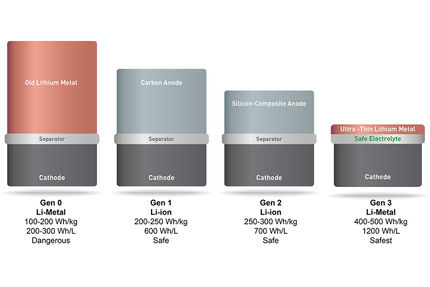Braided Current Collectors for Wearable Electronics
Braided Core Structure Boosts Energy Density in Fiber Lithium-Ion Batteries
Advertisement
An ultrathin braided wire in the core of an electrode increases the energy density of lithium-ion batteries, a team of researchers reports in the journal Angewandte Chemie. Batteries of this kind could be incorporated into functional textiles and used to supply power to smartphones and other electronic devices while we are wearing them. The new braided current collector structure replaces a single continuous wire and improves ion transport within the electrode, increasing charge density.

Symbolic image
Computer-generated image
Lithium-ion batteries (LIBs) are ubiquitous in devices ranging from smartphones to electric cars. We know them as made of a stack of electrodes in a bulky or cylindrical design. A novel battery variant reduces the stack to the dimensions of a thread made up of two long electrode fibers wound around each other. Woven into fabric, these very lightweight fiber batteries (FLIBs) can supply power to wearable electronics. Fiber batteries were declared one of IUPAC’s Top Ten Emerging Technologies in Chemistry in 2022.
However, there is a problem which needs to be solved before fiber batteries can be used to supply power to tents, functional clothing, and more; particularly in long fibers, energy density is far too low to be useful. Huisheng Peng and a team of researchers at the Fudan University in Shanghai (China) have now discovered that redesigning the current collector of the electrode could solve this problem.
The team decided to replace the current collector, which is a continuous, thin metal wire inside the graphite electrode, with a braid made of several much thinner metal threads. To produce the braid, they unwound several ultra-thin metal threads from spindles and braided them into a central braided thread, which was then coated with graphite over the whole electrode.
The new braided current collector was just as stable as the continuous wire, but made it possible to increase the energy density by interacting with the graphite. As the team explain: “The designed braiding structure leads to channels filled with active materials, reducing obstruction to lithium ion transport and increasing loading capability of active materials." This increased energy density was also demonstrated in tests: a woven textile was produced, containing 40 one-meter-long FLIBs with braided current collectors. This FLIB-based textile was able to charge a smartphone from 30 to 57 percent, whereas the conventional FLIB design using a continuous current collector wire only managed to reach 52 percent.
This increase in efficiency was achieved by a relatively simple change in the design of the current collector. This is particularly important for long fiber batteries which have to be robust, stable and also light.
Other news from the department science
These products might interest you
Most read news
More news from our other portals
See the theme worlds for related content
Topic World Battery Technology
The topic world Battery Technology combines relevant knowledge in a unique way. Here you will find everything about suppliers and their products, webinars, white papers, catalogs and brochures.

Topic World Battery Technology
The topic world Battery Technology combines relevant knowledge in a unique way. Here you will find everything about suppliers and their products, webinars, white papers, catalogs and brochures.





























































